孕产妇产前抑郁与新陈代谢的改变有关,而新陈代谢的改变可预测出生结果、神经发育和儿童心理健康。
IF 9.6
1区 医学
Q1 NEUROSCIENCES
引用次数: 0
摘要
背景:与产妇产前抑郁(AD)相关的代谢改变的证据有限,其作为潜在生物标志物在预测AD和不良的儿童出生、神经发育和心理健康结果方面的作用仍有待探索:在 331 个母子二人组中,我们研究了 AD(怀孕期间的医疗登记诊断史和/或流行病学研究中心抑郁量表评分≥20)与 95 项代谢指标之间的关联,这些指标在怀孕期间进行了三次分析。我们测试了与先天性心脏病相关的代谢指标是否增加了先天性心脏病对其风险因素的解释变异,以及儿童出生、神经发育和心理健康结果对先天性心脏病的解释变异。我们在 416 个母子二人组中重复了这一研究结果:结果:弹性净回归确定了 15 项代谢指标,这些指标共同解释了 25% (pConclusions:AD与15种代谢指标的变化有关,这些指标共同提高了对AD的预测,而不是对其风险因素的预测,也提高了对AD患儿的出生、神经发育和心理健康结果的预测。这些代谢指标可能会成为识别高危母亲和儿童的生物标志物,以便进行个性化干预。本文章由计算机程序翻译,如有差异,请以英文原文为准。
Maternal Antenatal Depression Is Associated With Metabolic Alterations That Predict Birth Outcomes and Child Neurodevelopment and Mental Health
Background
Evidence regarding metabolic alterations associated with maternal antenatal depression (AD) is limited, and their role as potential biomarkers that improve the prediction of AD and adverse childbirth, neurodevelopmental, and mental health outcomes remains unexplored.
Methods
In a cohort of 331 mother-child dyads, we studied associations between AD (a history of medical register diagnoses and/or a Center for Epidemiological Studies Depression Scale score during pregnancy ≥ 20) and 95 metabolic measures analyzed 3 times during pregnancy. We tested whether the AD-related metabolic measures increased variance explained in AD over its risk factors and in childbirth, neurodevelopmental, and mental health outcomes over AD. We replicated the findings in a cohort of 416 mother-child dyads.
Results
Elastic net regression identified 15 metabolic measures that collectively explained 25% (p < .0001) of the variance in AD, including amino and fatty acids, glucose, inflammation, and lipids. These metabolic measures increased the variance explained in AD over its risk factors (32.3%, p < .0001 vs. 12.6%, p = .004) and in child gestational age (9.0%, p < .0001 vs. 0.7%, p = .34), birth weight (9.0%, p = .03 vs. 0.7%, p = .33), developmental milestones at the age of 2.3 to 5.7 years (21.0%, p = .002 vs. 11.6%, p < .001), and any mental or behavioral disorder by the age of 13.1 to 16.8 years (25.2%, p = .03 vs. 5.0%, p = .11) over AD, child sex, and age. These findings were replicated in the independent cohort.
Conclusions
AD was associated with alterations in 15 metabolic measures, which collectively improved the prediction of AD over its risk factors and birth, neurodevelopmental, and mental health outcomes in children over AD. These metabolic measures may become biomarkers that can be used to identify at-risk mothers and children for personalized interventions.
求助全文
通过发布文献求助,成功后即可免费获取论文全文。
去求助
来源期刊

Biological Psychiatry
医学-精神病学
CiteScore
18.80
自引率
2.80%
发文量
1398
审稿时长
33 days
期刊介绍:
Biological Psychiatry is an official journal of the Society of Biological Psychiatry and was established in 1969. It is the first journal in the Biological Psychiatry family, which also includes Biological Psychiatry: Cognitive Neuroscience and Neuroimaging and Biological Psychiatry: Global Open Science. The Society's main goal is to promote excellence in scientific research and education in the fields related to the nature, causes, mechanisms, and treatments of disorders pertaining to thought, emotion, and behavior. To fulfill this mission, Biological Psychiatry publishes peer-reviewed, rapid-publication articles that present new findings from original basic, translational, and clinical mechanistic research, ultimately advancing our understanding of psychiatric disorders and their treatment. The journal also encourages the submission of reviews and commentaries on current research and topics of interest.
 求助内容:
求助内容: 应助结果提醒方式:
应助结果提醒方式:


